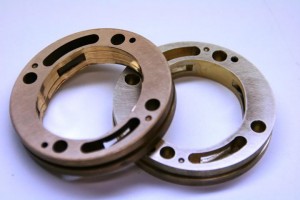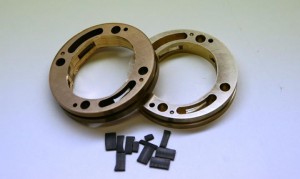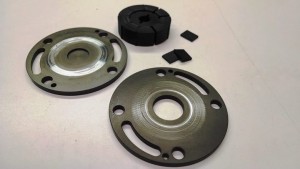Understanding cavitation and it
The most common failure of high flow fuel systems is cavitation, or lock. The combination of too much heat or too much inlet restriction can create this operating condition, where the liquid fuel literally vaporizes (boils) inside the pump assembly. The most common failure of high flow fuel systems is cavitation, or “vapor-lock”. The combination of too much heat or too much inlet restriction can create this operating condition, where the liquid fuel literally vaporizes (boils) inside the pump assembly. Symptoms of this operating condition may include one or more of the following:
- Dramatic loss of flow rate
- “Gauge Bouncing”
- Ratchet or grinding sounds from pump
- Inconsistent or loss of fuel pressure
- Temperatures above 120°F (50C)
As bad as the symptoms of this condition are, the results of this condition are often permanent, even if what caused the condition in the first place was fixed. Loss of fuel delivery pressure will also result in a lean-out condition as well that can result in engine damage. Typically, even with very short amounts of time of exposure to cavitation (depending on severity) will cause damage to the fuel pump. This damage results in a direct loss of capacity and efficiency. Often as noted when unchecked, this damage to the pump results in operating conditions that quickens cavitation exposure at each use. Eventually, the fuel system resorts to complete failure to build or maintain pressure. For all fuel systems of any manufacturer, this failure can be avoided as it is not a result of a manufacturing defect, but a result of a fuel system design failure. Two operating conditions can create the cavitation condition:
- High operating temperatures
- High inlet plumbing restrictions
High Operating Temperatures High fuel system operating temperature conditions can exist for several reasons including high inefficiencies (for example a worn or damaged pump), overly high fuel pressures, high flow rate pumps for long durations with low fuel amounts. Or it can result in secondary sources of heat such as engine heat, or exhaust heat. Most high flow EFI and carbureted fuel pumps are rated as “not continuous duty”. This is due to the amount of heat build-up that occurs over time as the fuel system is operating. When the fuel system has a high enough temperature the fuel will start to vaporize at the pump assembly – even with low pressure drop plumbing at the pump’s inlet. Once the fuel temperature is above 120°F (50C) the fuel is prone to vaporizing. A rule of thumb is: if it’s hot enough to be uncomfortable to the touch, then it is too hot. To allow for continuous or “street” use, voltage controllers are employed to reduce the pump speed during low engine demand operation to prevent heat build-up. Prodigy fuel pumps have a unique feature that allows reduction of speed without the need for an external pump controller.
High Inlet Plumbing Restrictions Some refer to pumps as “pushers” or “pullers”. The truth is that all pumps are both. This reference comes from the amount of resistance to cavitation a particular pump has versus another. Minimizing the amount of restriction feeding the pump’s inlet is a critical element to avoid cavitation. This is the main reason why typical OEM fuel systems have pumps mounted inside the fuel tank. Use of straining filters is required for the inlet of the fuel pump. They to provide fine enough filtering to protect the fuel pump, yet coarse enough not to inhibit flow, or capture enough particles to cause a building up of debris. Finer filtration, to protect the rest of the fuel system (such as fuel injectors and regulators) can be accomplished downstream of the fuel pump with a second filter. Typically, straining filters for fuel pumps elements have micron ratings from 25 to 150 micron rating. FUELAB recommends the use of 75 micron rating for Prodigy Series fuel pumps (75-150 micron required). Typically, modern OEM straining filters are at a lower micron rating and made of plastic weave cloth. These types of filters are adequate and desirable for OEM applications, however, the typical aftermarket fuel system has too high of a flow rate to accommodate this form of straining filter easily. The biggest mistake (and almost certain doom for a high flow fuel system) is to use a 10 micron filter upstream of the fuel pump. Plumbing size and the types of hose (or tube) play a vital role in the effects of cavitation as well general performance. The higher the flow rate, the larger the line size must be. Always avoid the use of check valves, or cross-drilled fittings when plumbing upstream of the fuel pump.
What Cavitation Damage Looks Like These pictures show the damage that can be done due to cavitation. The housing on the left shows cavitation damage and the housing on the right is how the housing should look. The last picture shows the cavitation damage to the wear plates. Although the damage may look minimal to some, it’s certainly not. If you understand machining principals and the tight tolerances that go into a modern build, it’s plain to see that there is a lot of damage here.

You can see the grooves cut into the housing from the broken carbon vanes (left) compared to the perfect housing on the right.

Same picture, with some added vane carnage.

The shiny/bare metal is cavitation damage. Much like a cylinder wall, it’s no good when you can feel the marks with your fingernail.
View our full line of High Performance fuel pumps here.

You must login to post comments.